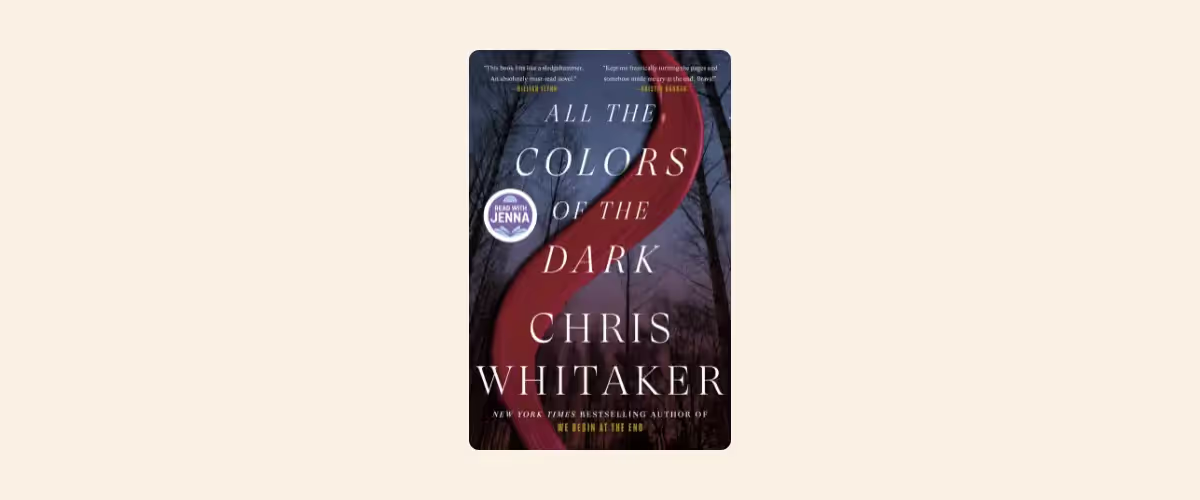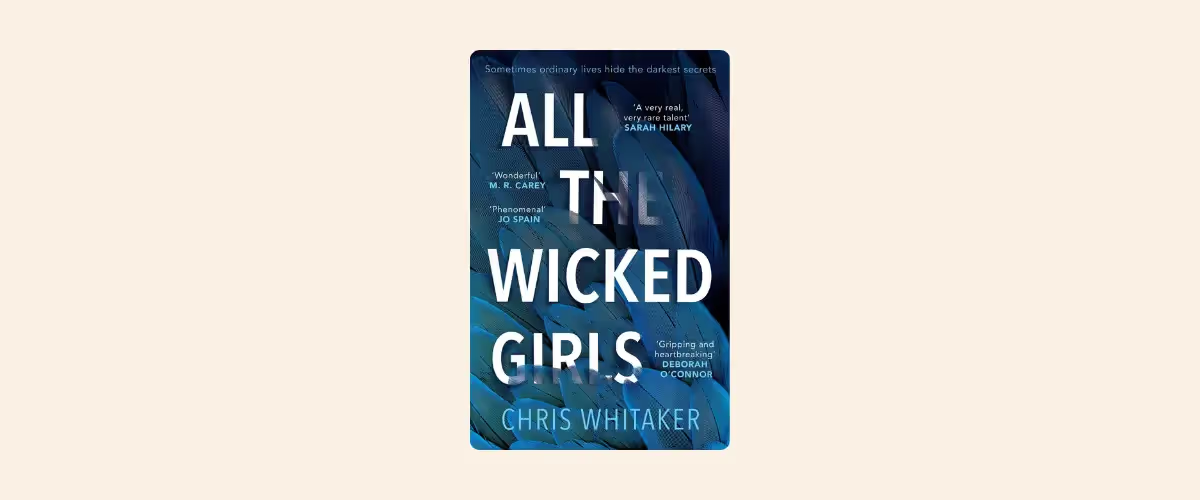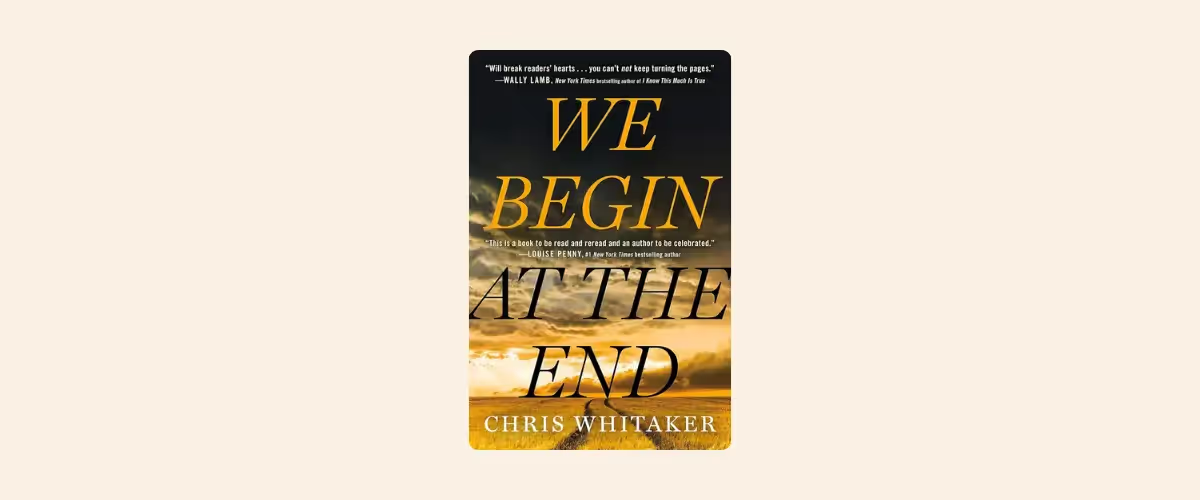Have you ever worried that your novel idea might be too ambitious?
If you’re envisioning genre lines that dictate what you can—and can’t—include in your story, we have good news: there is a million-copy-selling author topping the New York Times bestseller list right now, week after week, whose stories feature a more fluid interpretation of genre boundaries.
Meet Chris Whitaker.
Chris is the New York Times bestselling author of five published novels (Tall Oaks, All the Wicked Girls, We Begin At the End, The Forevers, and All the Colors of the Dark, the latter published in the U.K. as All the Colours of the Dark). The plots of Chris Whitaker’s novels include elements of crime thrillers, coming-of-age journeys, tales of drama and tragedy, epic love stories, and even a good old murder mystery.
Chris’s debut novel, Tall Oaks, won the CWA John Creasey New Blood Dagger Award in 2017, and since then, his other novels have picked up even more awards and accolades.
In 2021, his New York Times bestseller We Begin at the End won the CWA Gold Dagger, the Ned Kelly Award, and the Theakston Crime Novel of the Year, among other honors, including the Waterstones Thriller of the Month, with TV rights sold to Disney’s 20th Television.
All the Colors of the Dark
His most recent novel, All the Colors of the Dark, stormed the bookshelves and the bestseller lists in 2024, winning multiple book club picks and securing even more award nominations—and another television rights deal.

Telling a haunting story that spans decades, All the Colors of the Dark is a masterclass in defying genre boundaries. The epic and sweeping saga includes a missing-person mystery, a dark serial-killer thriller, and the grounding force of a love story (or, really, several love stories).
Set in 1975 in a small town in Missouri, this America, as written by Chris Whitaker, is one amid serious change: the last stages of the Vietnam War, a moment in time that colors the novel with its atmosphere of precarity.
While this novel is indeed a thriller, it is equally a monument to character development, the effects and embodiment of trauma, obsession, and the human necessity to create light in the dark.
Chris Whitaker’s writing advice
Members of The Novelry enjoyed a recent live writing class with Chris Whitaker. In the session, Chris discussed his creative process, how he wrote All the Colors of the Dark, his other novels, and his tips for writers.
In this article, we share five key pieces of advice we learned from Chris that you can use to inform—or color—your own writing.
You’ll discover advice on researching your novel, cutting words, editing, and composing dialogue that crackles.

If you’d like to watch the live class in full, sign up for any class at The Novelry and you’ll gain instant access to our Catch Up TV library featuring live writing classes from your favorite authors, including Chris Whitaker, Kristin Hannah (The Women), Bonnie Garmus (Lessons in Chemistry), Julia Quinn (Bridgerton), and Tayari Jones (An American Marriage), among hundreds of others.
1. Research: know everything your character can see, hear, and feel
We all know research matters, but if you ask for advice on it, the answer will likely differ every time. So, how much research should you undertake, and how much of it should go into your manuscript?
Writers are often warned about avoiding the ‘info dump’ at all costs: the moment where, in an effort to put your hours of research to use, you pour facts and details onto the pages of your manuscript without concern for your reader’s interest. However, there’s also the question of creating a vivid, authentic environment for your reader—particularly if you’re writing historical fiction, a genre that requires specific references gleaned from extensive research.
In his live writing class with us, Chris Whitaker shared his research process for All the Colors of the Dark. It should bring hope and delight to writers who love to escape into their research—with the bare-bones instruction to ‘read lots.’
Chris Whitaker’s research methodology
I spent hours, days, and weeks, with maps and travel guides; fiction, non-fiction, old newspapers, audio clips. I found a website where you can listen to people speak, so you can choose a town in the U.S. and then listen to someone read a transcript and you can pick up on speech patterns like that. So, I kind of drown myself in the detail.
—Chris Whitaker
Chris described his working set-up, which provides a visual representation of his thorough research process:
I work across three screens, as well. On the middle screen will be the manuscript; on the left-hand screen, I would have photographs of the woods in Missouri in the 70s; and on the right-hand screen, I would have everything that she can see, hear, and feel. Every type of plant that would be growing, what the weather would be like; if she steps onto the ground, how far would her foot sink into the earth? Every single detail about the scene I’m writing.
—Chris Whitaker
Here’s a fun question from Chris: do you know how far your main character’s foot would sink into the earth if they took a walk through your setting?
No?
It might be time to fall down another rabbit hole.

2. Overwrite massively, cut brutally
One of the most essential features of Chris’s research method and writing style is his tendency to overwrite massively and then cut brutally.
I massively overwrite the scene, and then I give every single detail you could imagine. And then I begin to cut.
I cut, cut, and cut until I’ve cut back to about the paragraph I need. That paragraph should make you feel like you’re standing next to Saint in the 70s, taking the walk with her.
And I do that for every scene in the book.
—Chris Whitaker
What this achieves, Chris concluded, is the disappearance of the author from the manuscript. You might imagine this level of detail places the author’s knowledge at the forefront of the novel, but in Chris’s eyes, the effect is the opposite. Enjoying the research and becoming immersed in the depths of it is essential to Chris Whitaker’s process—and short chapters can sometimes pack the biggest punch.
Quality, not quantity
I really immersed myself in all of it. I never see it as a chore, or something that’s getting in the way. I see it as my ticket to people understanding what I’m writing about, and people not noticing me in the story.
—Chris Whitaker
This might inspire a mindset shift for writers who dread the research portion of their process: the quality of your research grants you the ticket to being understood by your readers.

3. Meet your characters on the page
If you struggle to get your dialogue to sound natural—The Novelry has a blog for that—then Chris Whitaker has some insight that might reframe the way you think about your characters.
Are you revealing too many flaws or too much authenticity straight away when your characters are introduced to each other? If so, consider how people behave when they first meet in real life.
How Chris Whitaker writes dialogue
I was writing dialogue; I was writing conversations between the characters. I thought, how do I get to know someone in real life that I don’t know? How did I get to know my friends, how did I get to know my partner?
It’s through talking and listening. So I had these characters, and it was really interesting... I had all these early conversations between the two of them, where they’re presenting the shiniest sides of themselves, which is kind of what we do when we meet someone, or we go on a date.
You leave the bits out at first that you don’t really want people to see.
—Chris Whitaker
For a phrase that might ring through your head when writing, your characters ‘presenting the shiniest sides of themselves’ is a fantastic stimulus for understanding the dialogue needed for those early interactions.
4. Write the scenes you feel like writing—then put them together
While Chris Whitaker’s process for writing All the Colors of the Dark spanned four years, his approach to writing is perhaps simpler than many might expect.
I begin writing, but I write out of order, like how they film TV: I write whatever I feel like writing on any given day.
The hardest part to write is generally the opening page. I completely ignore it. There’s way too much pressure on it. I went straight into the middle of the book and write a scene, and write whatever I feel like writing—and I did that for the next year.
In the third year, I begin piecing it back together like a jigsaw puzzle. That’s when I first get an idea what the story looks like.
The fourth year is spent with editorial notes.
That’s the four years it took to write the book.
—Chris Whitaker

We often hear our guest authors admit they leave their opening page until last, so don’t fear this approach if you think it might work for you. Any way to ease the pressure off yourself and find pleasure in your manuscript is worth taking in our book!
Which leads us onto our final piece of wisdom from Chris Whitaker...
5. If you’re dreading your manuscript, it’s time to ask yourself why
It’s natural to have highs and lows while working on your novel, and many of us enjoy communal commiserations with our fellow writers when we hit a bad patch. However, if you are truly dreading returning to your manuscript every day, it might be time to step back and ask yourself why.
Sharing a piece of advice given by his literary agent, Chris offered this to our writers:
If you’re not enjoying it, you’re doing something wrong, generally.
I think if you’re sitting down every night and you’re dreading going back to your manuscript, you need to ask yourself why. Why is it so hard? Why is it so unenjoyable? And try to remember why you’re doing it in the first place.
—Chris Whitaker
Writing as survival
For me, primarily, the first reason for writing was survival. To make myself feel better because I was having a really difficult time. And so, generally, now when I sit down to write, I start from there.And if that means starting with something that you’re really looking forward to writing, then that’s what you should do.
—Chris Whitaker
Chris Whitaker’s relationship to writing, he commented, is one of survival. He approached it first as a therapeutic practice, and so it’s worth reminding yourself of the role writing plays in your own life. Why do you write? What is it about putting pen to paper (or fingertips to keyboard) that gives you that amazing feeling of creativity and escape?
.avif)
We hope you’ve enjoyed reading these insights from bestselling author Chris Whitaker. It’s true that wonderful things can happen when you discover a story you can’t wait to write, and that can become even more epic when, one day, the story becomes somebody’s favorite book.
Start a story you’ll look forward to delving into every day with The Novelry. When you join us on any creative writing class, you gain full access to our library of guest sessions, live writing classes, workshops, and special events—including this incredibly compelling session with Chris Whitaker.
Welcome home, writers. Join us on the world’s best creative writing courses to create, write, and complete your book. Sign up and start today.
.avif)
.avif)

.avif)
.avif)
.avif)
.avif)